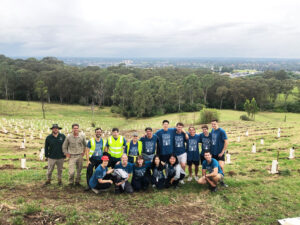
Greening our Garden
Returning 40 hectares of native canopy at Australia’s largest Botanic Garden
By Michael Elgey
In 2019 the Australian Botanic Garden Mount Annan (ABGMA) secured NSW State Government grant funding as part of the Greening Our City initiative. Our successful proposal was to plant 22,500 native trees and return a canopy that was unfortunately cleared during European colonisation. Yet being a botanic garden with conservation horticulture, education, and scientific research at our core, we wanted to do more.

The site of the ABGMA, before European colonisation, was predominately forested in what we now call the Cumberland Plain Woodland (CPW). Clearing commenced in the early 1800s and continued as the site fluctuated between different forms of agriculture up until the 1970s. With this disturbance came the introduction of exotic species. One species that has had a significant impact on the site is African Olive (Olea europaea subsp. cuspidata), which by 2010 had formed a dense 86-hectare forest across ABGMA. Over time, we reduced this infestation to 10-12 hectares. Many areas cleared of this insidious weed are being regenerated back to open grasslands, Cumberland Plain Woodlands or horticultural display areas but we wanted to return areas once dominated by African Olive, to a native forest and increase our urban tree canopy.

We successfully applied for the Greening Our City funding, with a commitment that the plantings would not just meet the NSW Premier’s Priorities but contribute to scientific research, horticulture and conservation. However, before a single plant went into the ground, we had to work through significant planning for success. This required cross-collaboration with our horticulturists, conservation ecologists, asset coordinators, contractors, and university research students.
Some of our critical criteria and steps included:
- Seed material secured from the Australian PlantBank and the Australian Tree Seed Centre
- All seeds to be wild-collected and of known provenance to allow use in future conservation projects
- Plants to be grown at ABGMA production nursery
- Species selections comprised of local endemics and species across the NSW
- Inclusion of species known to flourish in our localised conditions but species also not commonly used in horticulture
- Careful selection, design and preparation across 40.4 ha with varying aspects, topography, and soil conditions
- Implementation of ongoing watering and maintenance
- Every individual specimen is allocated a unique reference number, and GPS located

As stated, including scientific research in our plantings was essential, and we wanted long-lasting conservation contributions. These included:
- Increasing seed harvesting availability of species and genetic diversity for future conservation-restoration projects.
- Myrtle Rust, a threatening pathogen to many Australian Myrtaceae species, including Broad-leafed Paperbark (Melaleuca quinquenervia). This species shows variation in resistance to rust, allowing us to select resistant individuals to establish seed production areas for future restoration projects.
- The Ribbon Gum (Eucalyptus viminalis) suffers from eucalyptus dieback. Plots of this species were established in the Monaro district and replicated at ABGMA to help identify groups of individuals more resistant to this dieback. The idea is to plant seed production areas that produce more dieback-resistant progeny for restoring dieback-affected landscapes.
- Our understanding of the influence climatic provenance of seed material has on plant performance and resilience in dry, hot sites is rudimentary. To address this knowledge gap, two provenances with contrasting climates (temperature and rainfall) were selected for ten species and planted on the northern and southern slopes of Mount Annan to compare the performance and resilience of the different provenances.

- Biochar and soil microbial additives are believed to enhance the soil microbiome, and increase plant performance and resilience to low water availability. To test this, we planted ten species in dry, hot sites previously invaded by African Olive. The plants were planted on the northern and southern slopes of Mount Annan. We then applied four different biochar treatments, a soil microbial additive, both soil microbial additives and no soil microbial additive, to determine if they could negate the legacy effects of African Olives on the soil and increase plant performance and resilience under low water availability.
As a botanic garden, we also wanted to engage our community. So, we undertook several community and corporate planting days and a collaborative poetry competition we ran in conjunction with Red Room Poetry.
Even though we faced a pandemic and two years of La Nina (wet weather + clay soil + steep slopes = not ideal), the horticulture and delivery team at ABGMA still delivered a successful result. As of mid-December 2022, we determined our success rate at 90.6%, with a large proportion of mortalities attributed to herbivory by macropods plus over-saturation of the soil in selected areas.
Michael Elgey
Curator Manager
Australian Botanic Garden Mount Annan
T. 0448 746 414
Michael.elgey@botanicgardens.nsw.gov.au
